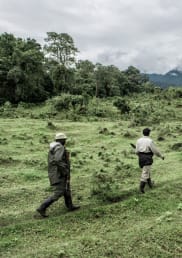Violent conflict plunges in Bangsamoro, Philippines, but peace still fragile
The number of violent incidents and deaths plunged in 2018 in the former Autonomous Region of Muslim Mindanao (ARMM) in southern Philippines, but the peace remains fragile. This is according to Conflict Alert, a subnational conflict monitoring system developed by International Alert Philippines.
Conflict Alert, which launched its 2019 report, tracks the incidence, causes, and human costs of violent conflict in the ARMM, including Isabela and Cotabato cities, and the Davao and Caraga regions. It has the largest database on subnational conflict in the country with more than 45,000 violent conflict incidents gathered from police reports, print media, and community sources.
Conflict Alert data show that conflict incidence across all provinces in the ARMM dropped 30% from 4,140 incidents in 2017 to 2,910 in 2018. Conflict deaths also decreased by 60% in 2018 from a year before from 2,261 to 900.
Nikki de la Rosa, International Alert Philippines country manager, explained that the fall in conflict incidence and deaths was partly due to the drop in coordinated attacks and the lesser use of explosives by various armed groups.
“The State was also able to maintain a fragile peace in the Bangsamoro by imposing martial law, which in turn deterred the carrying and use of firearms,” de la Rosa said.
According to the report, the Philippine National Police made more arrests for illegal possession of firearms in 2018 which resulted to a decline in gun-related deaths by 31% from 1,290 in 2017 to 891 in 2018. Bombing incidents declined from 193 incidents in 2017 to 166 in 2018 and were less deadly in 2018 with five deaths per incident, slightly down from six in 2017.
Not out of the woods yet
“The shift in conflict situation in the Bangsamoro certainly brings a more conducive environment for development to take place and for lasting peace to be embedded in what has often described as the most dangerous place in the country. However, it is not out of the woods yet,” de la Rosa added.
The level of violence in the ARMM remained significantly higher from 2016 to 2018 than the trend three years prior, according to Francisco Lara, Senior Peace and Conflict Adviser of Alert Philippines.
“Conflict deaths have also decreased, but not as low as in the years prior to the spike in 2016, when violent extremist incidents began to erupt just before the 2017 Marawi war,” Lara said.
Because of the fragile peace, certain conditions will have to be met before the military pulls out.
“The lifting of martial law in Mindanao is certain, but there has to be a political settlement on the use of weapons before it is lifted,” according to Lara.
De la Rosa pointed out that this is especially important in a region rife with multi-causal conflict that fuses identity issues with political issues, such as violent extremism, conflicts among rebel groups, and clan feuding related to political contestations.
“It is certainly critical because extremist violence remains resilient and resurgent. Tensions are rising because of the unexplainable delays in the Marawi reconstruction process that has added to the grievances of those affected, especially women and the youth,” de la Rosa said.



